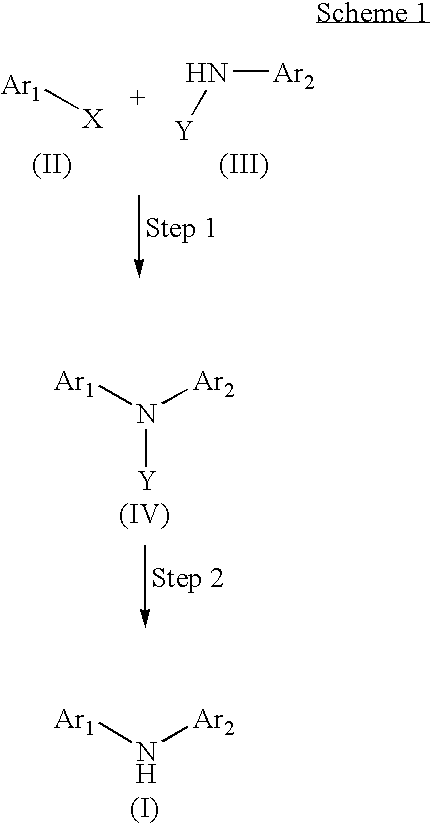Processes for the facile synthesis of diaryl amines and analogues thereof
a diaryl amine and facile synthesis technology, applied in the field of facile synthesis of diaryl amines and analogues thereof, can solve the problems of limited the scope of the palladium-catalyzed coupling reaction, low yield and purity, and few ways to make aryl amine-containing molecules without a significant amount of by, etc., to achieve easy reaction conditions, high yield and purity, and easy scale up for large-scale preparations
- Summary
- Abstract
- Description
- Claims
- Application Information
AI Technical Summary
Benefits of technology
Problems solved by technology
Method used
Image
Examples
example 1
[0183]
[0184]2-Chloro-nicotinic acid methyl ester (52): 52 was prepared according to the method of Synth. Comm. 26(12), 2257–2272 (1996). To a nitrogen purged flask was charged 2-chloro-nicotinic acid (1000.0 g, 6.0 moles, 1.0 eq) followed by 9 L methylene chloride. To this was added thionyl chloride (1.4 L, 19.7 moles, 3.2 eq.) and the reaction was heated to 40° C. with vigorous stirring under nitrogen overnight. The acid chloride solution was cooled in an ice bath and methanol (3 L, 74 moles, 12 eq.) was slowly added while keeping the temperature at 20° C. The rate limiting parameter is the vigorous evolution of copious quantities of HCl gas. After the addition, HPLC analysis [Tret starting material=7.5 min, Tret 52=11 min] showed the product had formed immediately. The volatiles were removed in vacuo and the residue extracted from 10% Na2CO3 with EtOAc. The combined organics were dried (MgSO4), filtered, and concentrated to a pale yellow oil.
example 2
[0185]
[0186]2-(4-Fluoro-phenyl)-nicotinic acid methyl ester (54): To a nitrogen purged flask was charged Pd(Ph3)4 (1.84 g, 1.6 mmoles, 0.005 eq), sodium carbonate (42.8 g, 404 mmoles, 1.3 eq), 52 (55.5 g, 320.6 mmoles, 1.0 eq), p-fluorophenylboronic acid (53.8 g, 384.7 mmoles, 1.2 eq), followed by 1.3 L denatured EtOH. The reaction was heated to 78° C. with vigorous stirring under N2 overnight. HPLC analysis [Tret 52=10 min, Tret 54=12 min] of the reaction mixture showed that the starting material was completely consumed and a later-eluting peak produced. The reaction was cooled to room temperature and the solvents removed under vacuum. The residue was dissolved in EtOAc, washed, dried (MgSO4), filtered through celite, and concentrated to afford a pale yellow solid 54.
example 3
[0187]
[0188]2-(4-Fluoro-phenyl)-1-oxy-nicotinic acid methyl ester (55): To a nitrogen purged flask was charged urea hydrogen peroxide (86.9 g, 924 mmoles, 4.0 eq.), the diaryl pyridine 54 (53.4 g, 231 mmoles, 1.0 eq) and 530 mL acetic acid. The bright yellow homogeneous solution was heated to 70–75° C. with vigorous stirring under nitrogen until the HPLC analysis [Tret 54=12 min, Tret 55=10 min] showed >97% completion. The reaction was cooled to room temperature and the contents slowly poured onto 500 g of ice. To the vigorously stirred icy mixture was slowly added 6N NaOH to pH 7 while maintaining a temperature of 30° C. EtOAc and NaHCO3 (solid) were added until an aqueous pH of 8–9 was reached, and the solids dissolved. The layers were separated and the aqueous layer back-extracted with EtOAc. The combined organics were washed with 5% NaHCO3 and then tested by peroxide test strips for the presence of oxidant. If the organic layer was positive for peracid, the bicarbonate washes we...
PUM
| Property | Measurement | Unit |
|---|---|---|
| Acidity | aaaaa | aaaaa |
Abstract
Description
Claims
Application Information
 Login to View More
Login to View More - R&D
- Intellectual Property
- Life Sciences
- Materials
- Tech Scout
- Unparalleled Data Quality
- Higher Quality Content
- 60% Fewer Hallucinations
Browse by: Latest US Patents, China's latest patents, Technical Efficacy Thesaurus, Application Domain, Technology Topic, Popular Technical Reports.
© 2025 PatSnap. All rights reserved.Legal|Privacy policy|Modern Slavery Act Transparency Statement|Sitemap|About US| Contact US: help@patsnap.com



